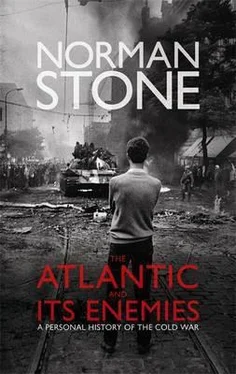The Left captured culture (broadly defined) and education, much as happened in England. Its denunciations of Reagan-and-Thatcher were loud, frequent and generally absurd. ‘The eighties’ passed into history as a decade of ‘greed’. There was an element of truth in this. The outstanding feature was that the better-off got better off, and the Economist was able to speculate, plausibly, that there was a return to the hereditary bourgeoisie, of substantial upper-middle-class families keeping their fortunes intact and passing them on to children and grandchildren, which had been a considerable feature of the English past. One aspect of this was certainly the reduction of top tax rates in the USA. For whatever reason, it did indeed have the effect of increasing government income from the top taxpayers, as the ‘supply-siders’ had claimed (to ridicule) would happen: 50 per cent. The top 1 per cent had paid 18 per cent of all revenues in 1981 and 28 per cent in 1988.
Still, there were ‘Seven Fat Years’, and this needs explanation. Median family income rose in 1990 dollars from $33,500 to $38,500. Five million new businesses emerged, and 18 million jobs were created. The stock market doubled in value, and inflation fell to a negligible figure: especially, oil prices declined, such that America returned to a cheap-energy world. It seems fair to say that the critics of the ‘supply-siders’ simply failed to foresee this, and, when they could not deny it, reckoned that it confirmed their own orthodoxies. Reagan characteristically remarked that a sure sign that it had worked was that it was no longer called ‘Reaganomics’. There was extraordinary criticism, still, and particularly of ‘the deficit’, which critics in other circumstances would have shrugged off. It was substantial, at 6.3 per cent of GDP in 1983, but with economic growth fell to 3 per cent in 1987, where it had been in 1981. Other countries had larger deficits; the American one mattered, because it brought in imports and thus carried other countries out of depression. It was also very easily covered by capital imports, since the world invested in America. The real objections to Reagan were of a different order altogether: they had to do with the displacement of ‘hegemony’. The Californian business cronies with whom Reagan filled his Cabinet could not have cared less for the opinions of J. K. Galbraith, despised the seventies, regarded universities as pollution. Reagan himself, criticized for not having economists around, remarked, why should he: his Cabinet consisted of millionaires.
Was it true that ‘the middle’ was stagnant and ‘the poor’ were poorer, while there was ‘obscene’ wealth? Such was a theme of critics in all areas. There was no doubt as to the money made out of money: Wall Street entered legend, as did the London City. In 1980 there were almost no billionaires, and in 1989 there were over fifty. There had been under 5,000 millionaires; then there were 35,000. There had been 500,000 people with assets worth one million; then there were 1.5 million. In England there was a joke that a millionaire was just someone without a second mortgage in Fulham, so far had house prices risen. Then again, the ‘middle’ was not ‘stagnant’ at all, given that the percentage of families earning $50,000 (1989) rose from 31 to 36 per cent, thus rated (no doubt misleadingly, but the losing 1984 Democratic presidential candidate, Walter ‘Fritz’ Mondale, regarded an income of $60,000 as defining ‘rich’) as ‘affluent’. There was also a huge increase in charitable giving — more than $100bn in 1990, an increase of over half in the decade.
Besides, poverty, as ever, defied generalizations. A student was poor, and so was a pensioner, even if living in a large house. People moved jobs, and got divorced, before rebounding. Then again, there was the ‘underclass’ — a problem that hardly existed in countries such as Sweden, where people who refused to work faced severe punishment, unthinkable in the USA. It was of course true that economic change greatly affected whole classes of people such as blue-collar workers and (some) farmers, but that was not a problem peculiar to the eighties: it had been a strong feature of the seventies, when the expression ‘rust belt’ came to describe Sheffields or Baltimores or Pittsburghs that had previously been steel towns, now facing competition from much cheaper producers abroad. In the 1980s, on the wreckage of these older industries, new ones shot up, generally referred to as ‘service’, but in themselves requiring sophisticated machinery. The computer was sometimes held to be as revolutionary as the railway had been for the nineteenth century. But the proper comparison is with the automobile, which had brought about the 1930s recovery in the industrial West. The recession released capital and labour in a great wave, and after the initial troubles the country boomed. But so did important places beyond the USA.
But it was not just the internal blockage that gave Reagan his financial troubles. He had also decided on a course of rearmament, known as the ‘Second Cold War’, and it proved expensive, only really justified by a belief that matters could not be left to drift. The background, as in most matters, lay in Carter’s failures. The experience of détente had not been positive, and part of the Reaganites’ strategy was a challenge to the USSR. This included defiance over weaponry. It also meant a new spirit in the CIA, rather cowed since Vietnam days: why not challenge the Soviet Union directly? Its civilian economy worked, everyone knew, badly. Why was it now building a very large navy, exploiting any advantage on the edges of the Middle East — Ethiopia, then Afghanistan — and probing mineral-rich southern Africa? The spirit in the United States became antagonistic. European misgivings were swept aside; a ‘working breakfast’ between Alexander Haig, the Secretary of State, and Helmut Schmidt, early in 1982, was marked by enraged shouting, over Poland. At the time Caspar Weinberger was preparing a document as to how the offensive should be undertaken. The general idea was to identify which technologies really mattered to the USSR, and to invest ‘in weapon systems that render the accumulative Soviet equipment obsolescent’. William Clark for the National Security Council said that ‘trade and finance should emerge as new priorities in our broader effort to contain and roll back Soviet operations worldwide’. But it was not just trade and finance or even brilliant new weaponry, such as ‘smart bombs’ and laser-beam anti-missile technology. The Americans had looked hard, since the Vietnam disaster, and considered what had gone wrong; and they now had two concrete cases from which to build up arguments.
The twentieth century was to end with a grotesque joker from the seventies crisis pack. In 1999 a very frail 84-year-old Chilean general, long in retirement, was arrested in London, in the watches of the night, in his hospital bed. The general, Augusto Pinochet, had his drip-feed detached, and he was taken off to prison, there to face charges that related to events that had occurred a quarter-century before, half a world away from London. The legal details were also bizarre. A Spanish judge, who had himself served a dictatorship quite faithfully as chief prosecutor, had issued a warrant for the general’s arrest, on human rights charges; it was to Spain, not Chile, that the old man was supposed to be extradited. But, in Spain, even had he been convicted, he could not have been imprisoned: people over seventy-five were let off. The Pinochet case was, in other words, absurd.
But it was very deeply felt, by the general’s enemies. The ‘Pinochet coup’ on 11 September 1973 had acquired worldwide significance, and was viciously remembered by the generation of 1968. The Chilean armed forces had struck, and deposed one of its heroes, Salvador Allende, the Marxist president of Chile. He died when his presidential palace was stormed, and became a martyr. Pinochet was said to have overthrown Chilean democracy and, with sinister American advisers, to have initiated a reign of terror: there were voluble exiles, with tales of ‘disappearances’, of mass executions in football stadiums, of torture in dank basements or freezing, sub-Antarctic camps. When the people of 1968 came to office in Washington, with President Carter in the later 1970s, they wanted to distance themselves from Pinochet. The Americans had been involved in the coup, which was even said to have originated with the CIA, and Carter accused Nixon of destroying ‘elected governments, like in Chile’. In 1977 the US representative at the United Nations Human Rights Commission in Geneva stated his ‘profoundest regrets’ for the ‘despicable… acts of subversion of the democratic institutions of Chile, taken by certain US officials, agencies and private groups’. It was characteristic of the hatred displayed that the New York Times ran sixty-six articles on the Chilean affair and the opposition to it, but only three on Cuba and four on Cambodia.
Читать дальше












![Edward Ellis - Adrift on the Pacific - A Boys [sic] Story of the Sea and its Perils](/books/753342/edward-ellis-adrift-on-the-pacific-a-boys-sic-s-thumb.webp)